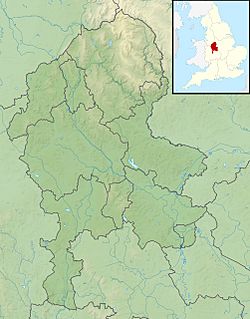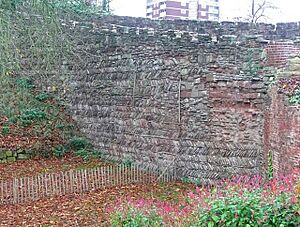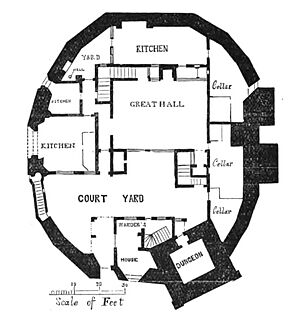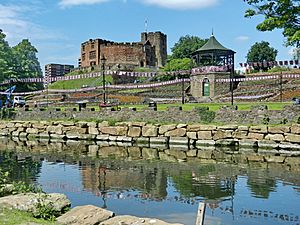Tamworth Castle facts for kids
Quick facts for kids Tamworth Castle |
|
|---|---|
| Tamworth, Staffordshire, United Kingdom | |

Tamworth Castle
|
|
| Coordinates | 52°37′58″N 1°41′48″W / 52.63278°N 1.69667°W |
| Site information | |
| Owner | Tamworth Borough Council |
| Open to the public |
Yes |
| Site history | |
| Built | 1080s |
| Built by | Robert le Despencer |
Tamworth Castle is a very old Norman castle in Tamworth, Staffordshire, England. It sits high up, looking over where the River Anker meets the River Tame. This castle is a special Grade I listed building, meaning it's very important historically.
Long ago, this spot was home to the kings of Mercia during Anglo Saxon times. But it was left empty when the Vikings attacked. Later, the Normans made it strong again and built it bigger. Today, Tamworth Castle is one of the best examples of a motte-and-bailey castle in England. A motte-and-bailey castle has a tall mound (the motte) with a tower, and a walled courtyard (the bailey) below.
Contents
History of Tamworth Castle
Early Days: Anglo-Saxons and Vikings
Tamworth was once a very important place for King Offa, a powerful ruler of the Mercian kingdom. He built a palace there in the late 700s. Important papers were signed from his royal palace in Tamworth.
However, in 874, the Vikings attacked. They left the town in ruins for nearly 40 years. Then, in 913, Æthelflæd, a strong leader known as the Lady of the Mercians, rebuilt Tamworth. She added new earthen walls, called a burh, to protect the town. But these defenses did not stop another Viking attack in 943.
After these attacks, Tamworth was no longer a royal home. But it still had a mint where coins were made for later Anglo-Saxon kings. Coins were even made for the new Norman king, William the Conqueror.
The Normans and the Marmion Family
After the Norman Conquest, King William gave the land to his steward, Robert Despenser. In the 1080s, Robert built a wooden castle. This was a typical Norman motte-and-bailey castle. It was built on the southwestern part of the older burh. This wooden castle was the first version of the castle we see today.
Robert Despenser did not have children. So, the castle went to his nieces. One niece, Matilda, married Robert Marmion. The Marmion family then owned the castle for six generations, from about 1100 to 1294. They were the traditional champions for the Dukes of Normandy and later for the Kings of England.
During the Marmion family's time, the castle started to be rebuilt with stone. But at one point, it was almost completely destroyed! In 1215, Robert Marmion, 3rd Baron Marmion of Tamworth, stopped supporting King John. Because of this, King John ordered Robert's son to be put in prison. He also ordered that all of Robert's lands be taken away and Tamworth Castle be torn down.
Luckily, the castle was only partly destroyed when King John died the next year. Robert's sons were then able to get their father's lands back.
The last male Marmion to own the castle was Philip Marmion. He had no sons, so when he died around 1291, the castle went to his daughter. After she died without children in 1294, it went to her niece, Joan. Joan was married to Sir Alexander Freville. Their family, the Frevilles, owned the castle until 1423.
The Freville family's male line ended with Baldwin de Freville. His son died young. So, the castle passed to the oldest daughter, Elizabeth, and her husband, Thomas Ferrers of Groby.
Castle Changes Over Time
Many parts were added to the castle over hundreds of years. A lot of changes happened during the Jacobean period (early 1600s). From this time, you can see the family symbols of the Ferrers and the families they married into all over the inside of the castle.
The main part of the castle, called the shell keep, has a gate tower from the 1100s. It also has living areas. There's a three-story northern part from the 1200s and a three-story southern part from the 1600s. These are connected by a large wooden Great Hall from the 1400s.
Outside the castle, you can still see a special pattern of bricks called herring-bone masonry. These bricks are laid diagonally at the bottom of the path leading up to the gate tower. This pattern is very old.
Tamworth Castle in Modern Times
Long ago, you entered the castle grounds through a gateway near the town's market. In the 1500s, a visitor named John Leland noted that the outer walls were falling down. But he also said that Mr. Humphrey Ferrers was living in and fixing the "great round Tower of Stone" on the mound.
Even though the castle was used as a home, its defenses were built for medieval wars. During the English Civil War, Parliament's army captured the castle on June 25, 1643. It took them only two days. The castle was then used by Parliament's soldiers. In July 1645, there were 10 officers and 77 soldiers living there. Because the castle was used by the army, it was saved from being destroyed, which happened to many other castles at that time.
After 1668, the castle was passed to relatives of the Ferrers family. First, it went to the Shirleys of Chartley. Then, in 1715, it went to the Comptons when Elizabeth Ferrers married the 5th Earl of Northampton. During their time, the castle again started to fall apart.
But then, the Ferrers' grandniece, Charlotte Compton, married George Townshend. They fixed up the castle again. After George Townshend died in 1811, the castle was bought by an auctioneer named John Robbins in 1814. He moved in in 1821. After he died, the Townshend family got the castle back.
The moat on the town side of the castle was no longer used. From the 1400s, parts of it were rented out to houses on Market Street. In 1810, a new gatehouse was built at the bottom of the Holloway. From there, a road wound up through the grounds to the castle's entrance.
The castle mill was located further along the River Anker. The famous artist J. M. W. Turner painted it in his beautiful watercolour of the castle from 1832. His painting also shows the Lady Bridge and the square tower of St. Editha's Church.
Finally, in 1891, the Marquess Townshend decided to sell the castle. Tamworth Corporation (now Tamworth Borough Council) bought it for £3,000 in 1897. This was to celebrate Queen Victoria's diamond jubilee. The castle was then opened to the public as a museum in 1899 by the Earl of Dartmouth.
Royal Visitors to Tamworth Castle
Many important royal figures have visited Tamworth Castle over the centuries:
- King Henry I, between 1109 and 1115
- King Henry II, in 1158, with Thomas Becket
- King Henry III, in 1257
- King Edward II, in 1325
- King Edward III, in 1330
- King James I, in 1619, with his son Prince Charles
- Anne, Princess Royal in 1988
See also
- Castles in Great Britain and Ireland
- List of Grade I listed buildings in Staffordshire
- Listed buildings in Tamworth, Staffordshire
- Mercian Trail
- Tamworth Castle Website





